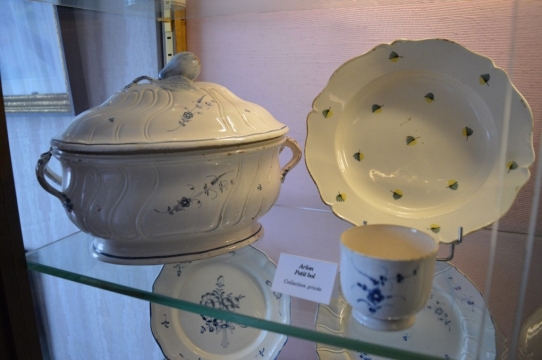These refined and high-quality glazed pieces of earthenware are exceptional. They are difficult to find today because of the rather brief existence of the Arlon Imperial and Royal Manufacture, and are a perfect example of the knowhow of Arlon faience. Thanks to their acquisition by the Marcel Van Rooy – Elise De Smet Fund, they are now exhibited at the Gaspar Museum in Arlon, just a stone’s throw from where they were produced.
The Arlon Imperial and Royal Manufacture
This exceptional ensemble is representative of the faience produced by the Arlon Imperial and Royal Manufacture, founded in 1781 by a former worker from the Faïencerie Boch in Septfontaines (currently Villeroy & Boch in Luxemburg). Stimulated by the commercial success of the Faïencerie Boch, the Viennese painter Ignace Kryhuber decided to set up his own business. When he began in 1781, with neither the time nor the money to train his own workers, Kryhuber poached workers from Boch, who duly arrived at the new company furtively bearing moulds, raw materials and even ready-prepared colours.
Arlon earthenware
In its early days, the Arlon Manufacture copied the white earthenware decorated in blue that was in vogue and produced by Boch, the company’s famous competitor. Most of the 19 pieces in this collection illustrate this well, with decoration including the Chantilly twig, Louis XVI garlands (there are two identical plates in the Museum of Art & History in Brussels) and cornflowers. However, the Arlon Manufacture did not limit itself to imitation: it also created faience with the motifs of large yellow and green oak leaves, which would make their work famous. Four pieces bearing this decoration enrich this ensemble. These high-quality pieces demonstrate well the beautiful tableware employed in bourgeois homes as well as Arlon know-how.
Rare and sought-after faience
Despite its great quality, the Arlon earthenware company only lasted for some twenty years. Deprived of its means of production after the 1785 fire in the town, it was only five years later, in 1790, that the company began doing business again. However, production was regularly interrupted, notably by the invasion of the French revolutionary troops. Faced with serious production and supply problems, the company was unable to recover and eventually closed its doors for ever. It is due to the short life of the Arlon Manufacture, the small quantity of products it produced and their age that Arlon faience is now particularly sought after and difficult to find.
High-quality regional production that everyone can admire
Thanks to their acquisition by the Marcel Van Rooy – Elise De Smet Fund, which has entrusted them to the Gaspar Museum in Arlon, these rare and precious pieces of earthenware manufactured a stone’s throw from where they are now exhibited, can also be discovered by the general public. The Marcel Van Rooy – Elise De Smet Fund, managed by the King Baudouin Foundation, devotes itself to the acquisition and conservation of works of art in earthenware and porcelain in an effort to promote ceramic collections in Belgian museums.
